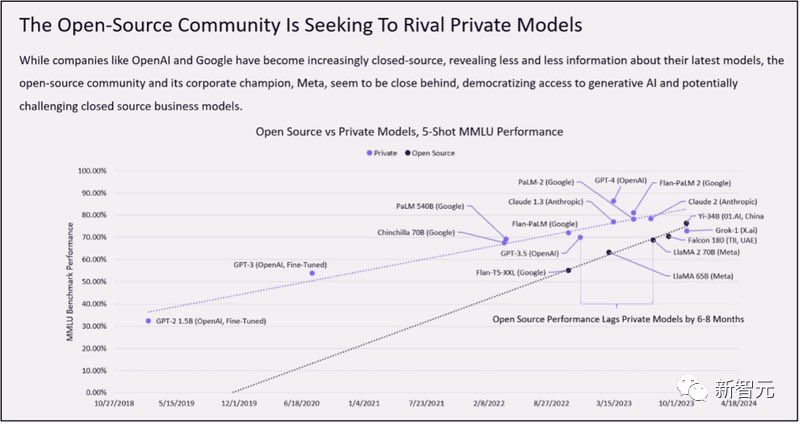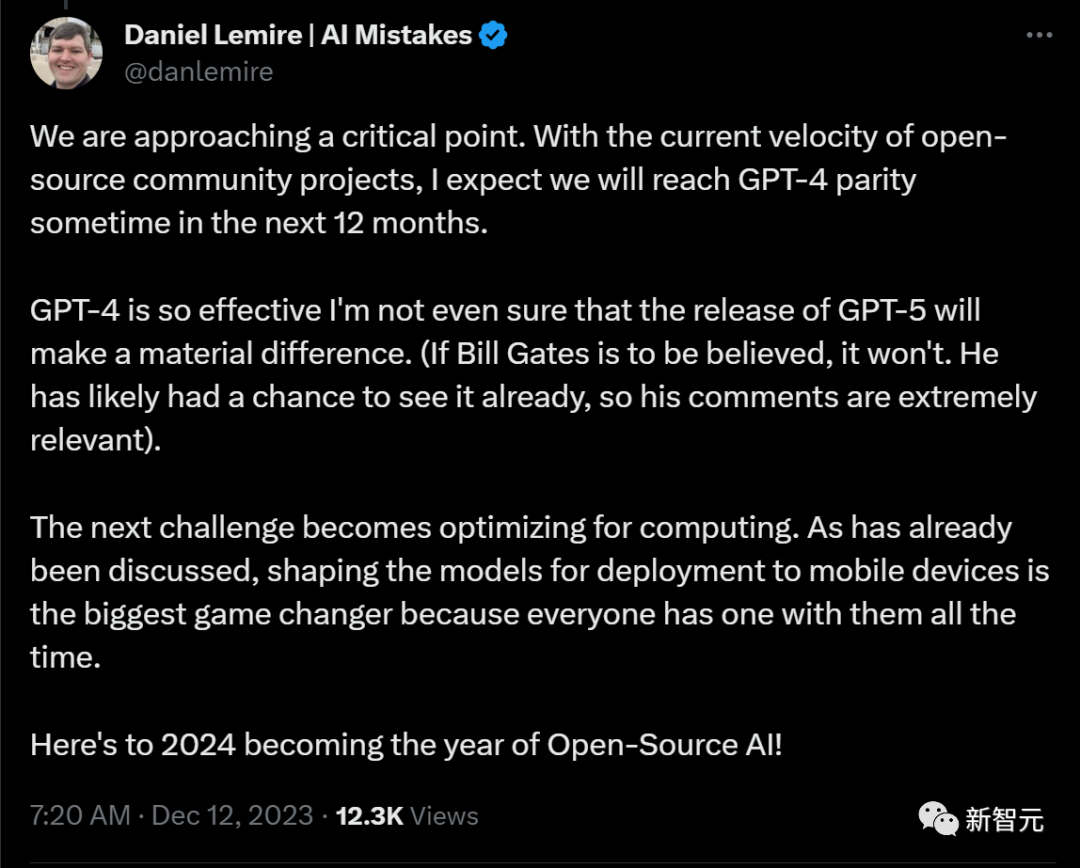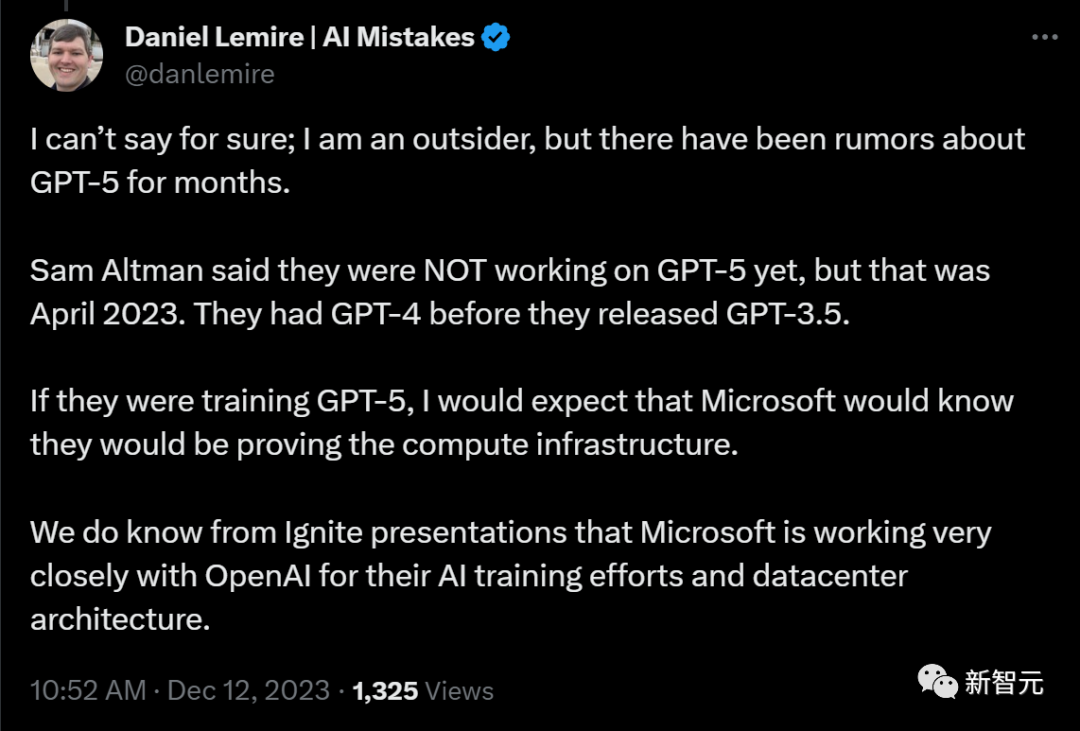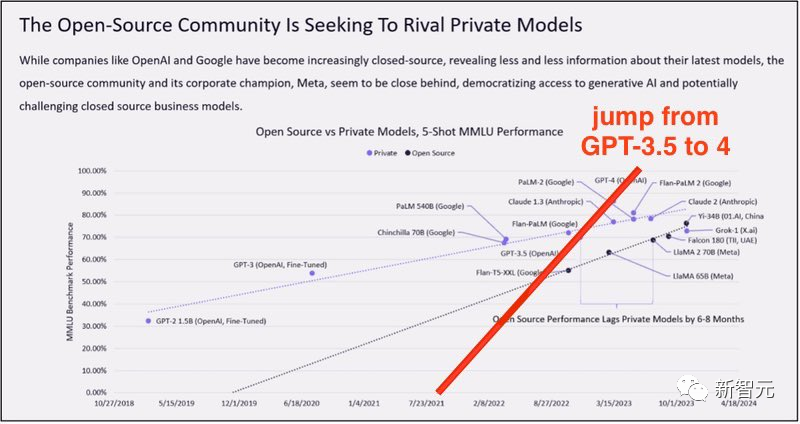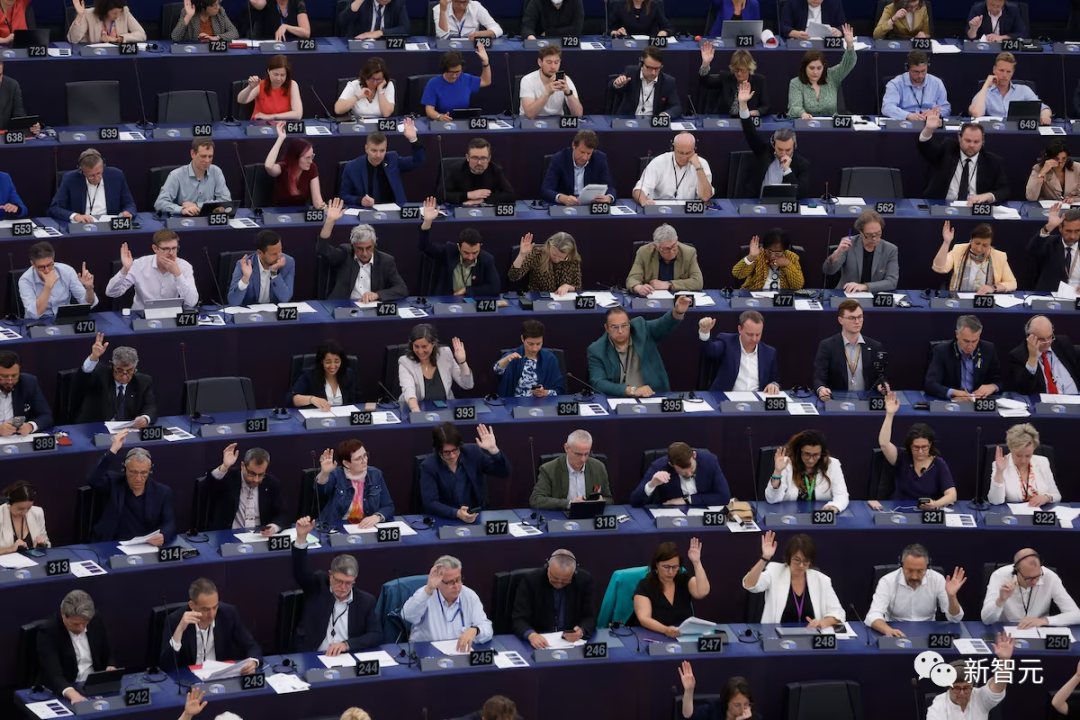Recently, this image, which is called "perhaps one of the most important AI charts of 2024," has started to become popular in the AI community. It can be seen that open-source local models have replaced large-scale, cloud-based, expensive closed models. This shift is exciting and fascinating.
Source: New Element
Image source: Generated by Wujie AI
Recently, this image has been circulating in the AI community, and even LeCun has reposted it.
This image intuitively shows the competitive landscape between the AI open-source community and private models.
In the 5-Shot MMLU benchmark test, the performance of the two lines representing open-source models and closed-source models is expected to intersect within 2 years.
Although companies like OpenAI and Google are striving to monopolize the information of the latest models, the open-source community represented by Meta is vigorously promoting more accessible generative AI, which may challenge the traditional closed-source AI development model.
Chart created by CathieDWood's ARKInvest
Many people say that this may be one of the most important AI charts of 2024.
It can be seen that the recent rise of open-source local models has already surpassed large-scale and expensive cloud-based closed models!
The power of collaboration and open-source innovation is truly remarkable.
Will 2024 be the year of open source?
Excited netizens wrote—
We are approaching a tipping point. At the current rate of open-source community projects, we are expected to reach a level similar to GPT-4 within the next 12 months.
GPT-4 is so powerful that I am not sure if the release of GPT-5 will have a substantial impact.
The next challenge is to optimize for computation. As mentioned earlier, shaping models for deployment on mobile devices is the biggest game-changer, as everyone has a mobile device.
2024 will be the year of open-source AI!
Clearly, there have been rumors about GPT-5 in recent months.
Some people simply added a line directly to the chart.
Some people say that this chart only shows what everyone already knows.
GPT-4 is actually in a league of its own; it is an outlier and not suitable to be placed on the trajectory.
Claude does have excellent UI and a longer context window, but it is expanding horizontally.
Gemini Ultra is quite eye-catching.
The rise of open-source local models, replacing large-scale, expensive, cloud-based closed models, is truly exciting!
This shift can democratize artificial intelligence, generate more widespread innovation, and allow smaller participants to obtain powerful tools without requiring significant investment.
Some people suggest adding Bloom with a score of 39.13 in August 2022, adding Mistral 7B with a score of 64.7 in October 2023, and adding MoE 8x7B Mixtral with a score of 71.3 in December 2023.
"Can't believe such a good thing is free. We live in such a good era!"
Some people have opened up their minds: If we have an open-source model that is 10 times cheaper and 10 times more powerful, then according to the Jevons paradox in economics, we can predict that our model will be equally expensive but 100 times more powerful—if supply is the limiting factor, demand will correspondingly explode.
If this pace is maintained, we will probably see AGI in about a year.
Of course, some people have pointed out that the chart is not rigorous.
Some more terrifying exceptions of closed-source models can be found, which would lower the average.
So, the comparison should not be made based on the average value here, but rather on the maximum value within each category.
Some people also say that if exceptional values like Grok, GPT-2, and GPT-3 are removed, the slope change of private models would be significant, leading to the opposite conclusion.
EU Artificial Intelligence Act Negotiations Conclude: Extensive Exemptions for Open Source Models
The good news is that legally, countries are also showing a more tolerant attitude towards open-source models.
In early December, negotiations on the "EU Artificial Intelligence Act" concluded.
Legislators voted on the "Artificial Intelligence Act" in the European Parliament in June.
The negotiations left a controversial issue, which is how to regulate basic models, especially open-source models.
LeCun specifically posted to thank the "governments of France, Germany, and Italy for not giving up on open-source models."
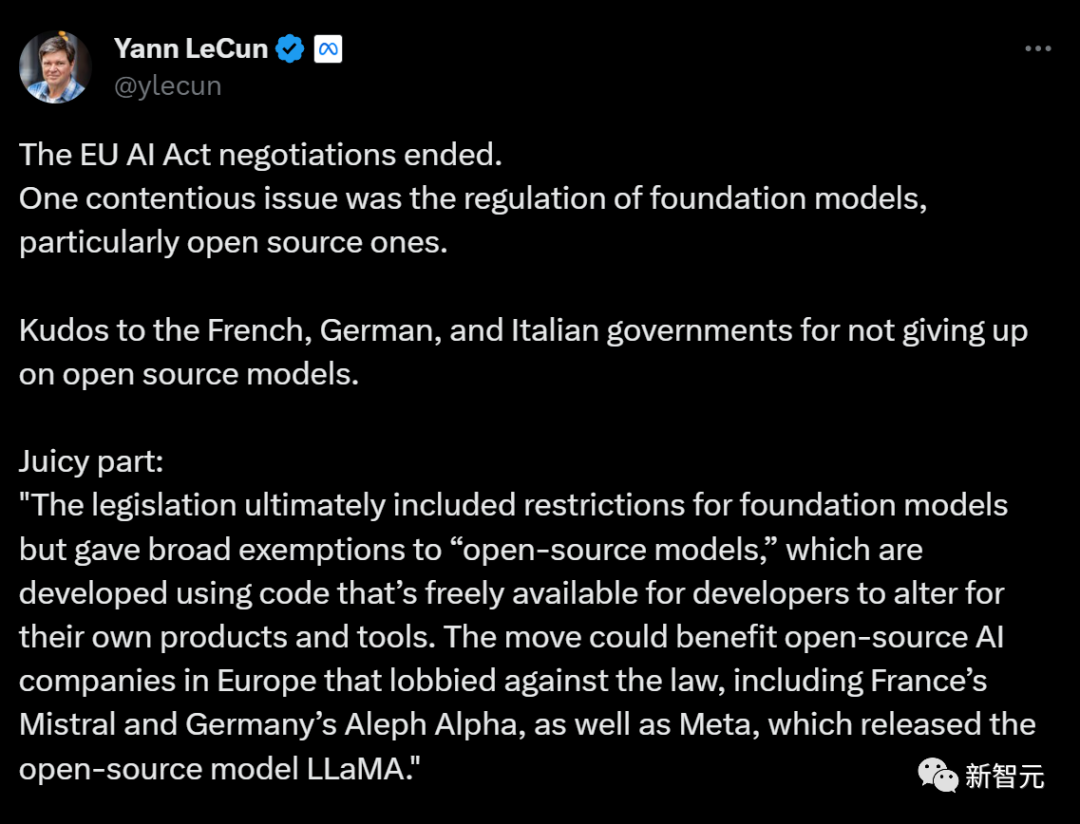
This legislation includes restrictions on basic models, but it provides extensive exemptions for "open source models."
LeCun stated that this move may benefit European open-source AI companies lobbying against this law, including Mistral in France, Aleph Alpha in Germany, and Meta, which has released the open-source model LLaMA.
Meta and IBM Lead the Establishment of the Open Source Alliance
On December 6th, more than 50 tech giants, universities, and institutions jointly established a new AI alliance under the banner of open source, vowing to compete with OpenAI and NVIDIA.
The AI alliance is led by Meta and IBM, with a total of more than 50 tech companies, universities, and institutions jointly established.

Among the members of the alliance, there are many well-established tech companies: AMD, Intel, Dell, Oracle, Sony, as well as startups that have risen after the AI wave: Hugging Face, Stability AI.


The universities among the members are mainly from the United States, including many well-known computer science institutions such as UC Berkeley, Yale, Cornell, UIUC, New York University, as well as highly reputable universities outside the United States: Imperial College London, ETH Zurich, University of Tokyo, Hebrew University, and others.


The organizational members even include government agencies such as NASA.
According to Meta's official statement, the main task of the alliance is to "support open innovation and open science."
Darío Gil, Senior Vice President of IBM and Director of IBM Research, stated: "If you think the future of artificial intelligence will be determined by two, three, or five institutions, you are wrong."
"I hope it (the alliance) will make people clearer and more confident in believing that the world of open innovation is a world worth investing in."
According to official data from the AI alliance, these 50+ organizations bring together over $80 billion in annual R&D funding, with over 400,000 students in research institutions and over 1 million employees in companies.
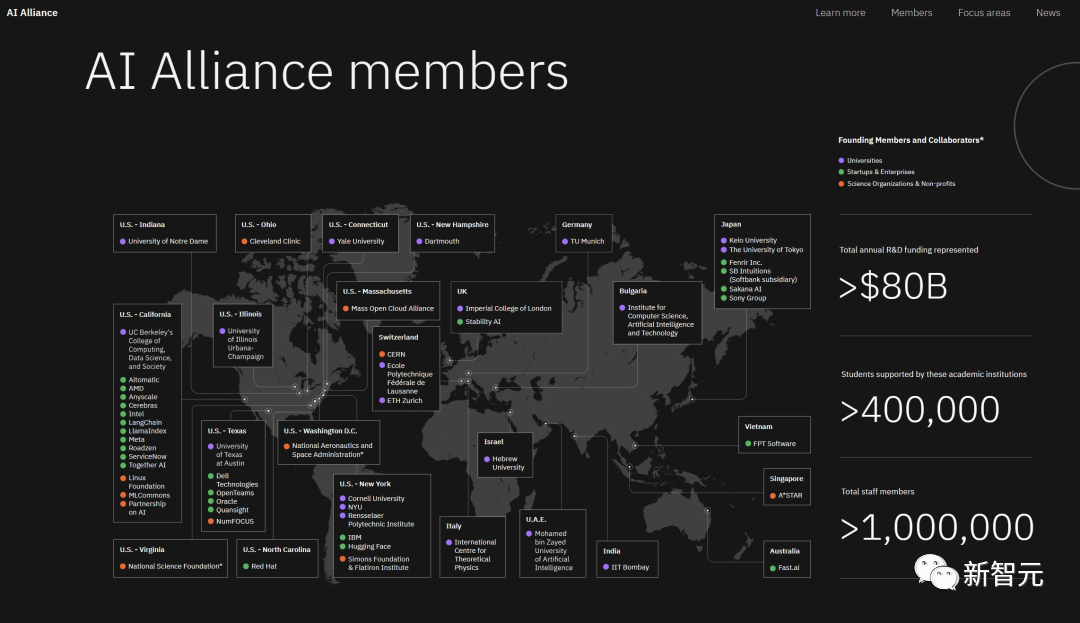
Supporters of open source from around the world have united!
Reference: Twitter - Brian Roemmele
免责声明:本文章仅代表作者个人观点,不代表本平台的立场和观点。本文章仅供信息分享,不构成对任何人的任何投资建议。用户与作者之间的任何争议,与本平台无关。如网页中刊载的文章或图片涉及侵权,请提供相关的权利证明和身份证明发送邮件到support@aicoin.com,本平台相关工作人员将会进行核查。

